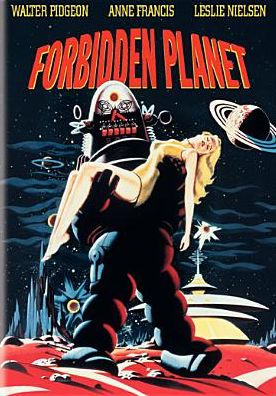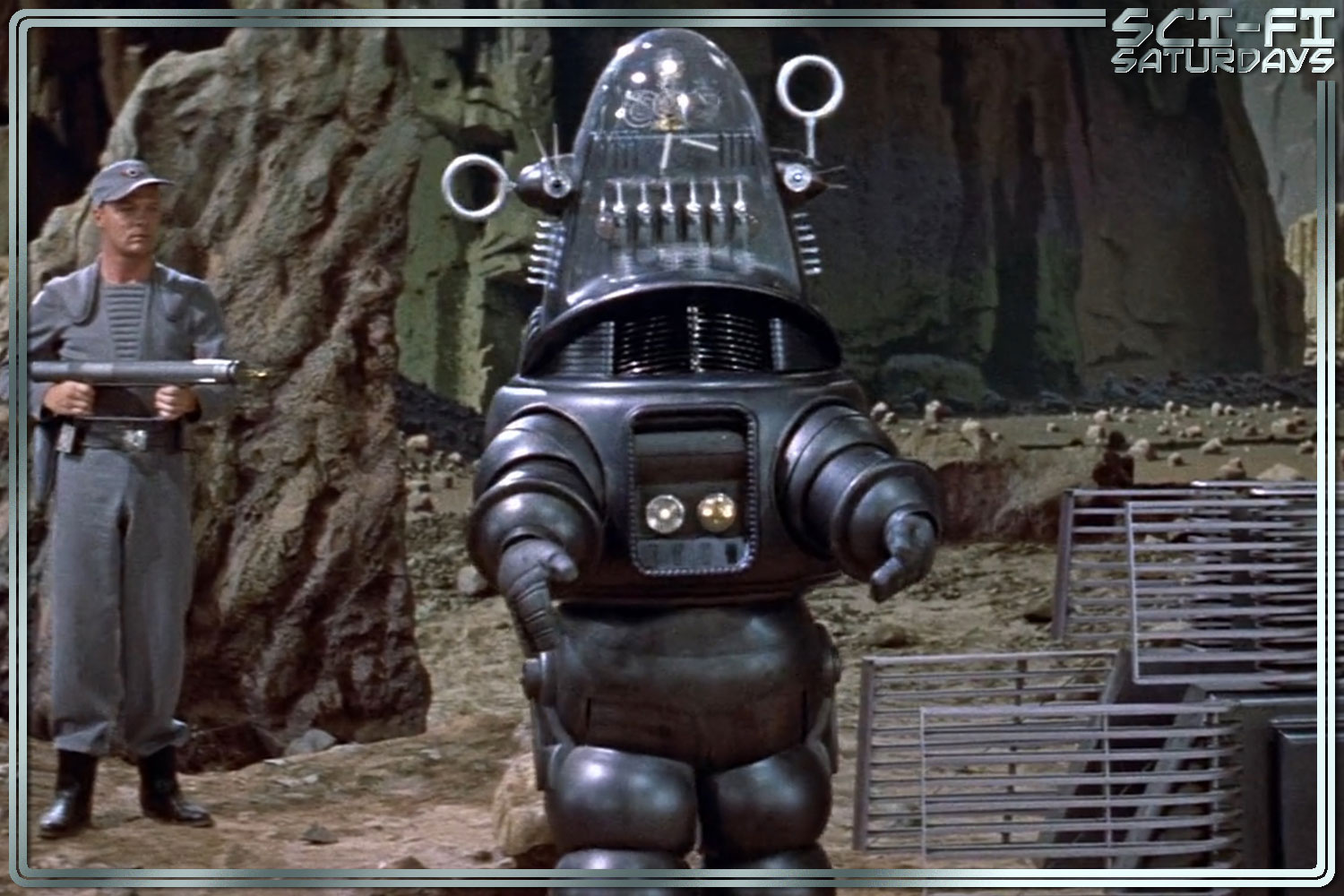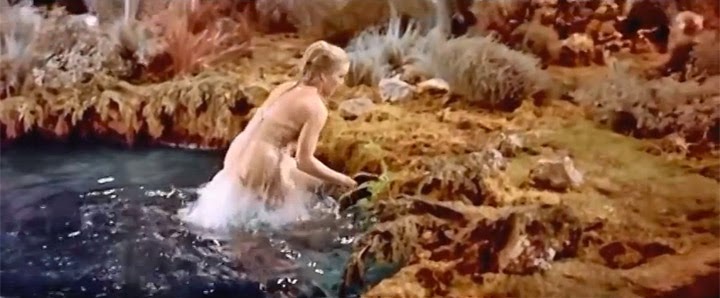RE:View Forbidden Planet

UPDATE: 12/4/24 Earl Holliman, long standing Hollywood character actor and last remaining star of the 1956 sci-fi classic has passed away. In Cookie’s honor I have bumped up this post.
Forbidden Planet is arguably the most influential space opera of the 20th century.
Yes, I’m including 2001, Star Wars, and Alien in that statement. The reason is simple it was genesis. There were elements of all three of those films in Forbidden Planet. Sure, there were space opera movies before Forbidden Planet. But most were serials that were heavily influenced by Edgar Rice Burroughs like Flash Gordan or Buck Rogers.
George Pal produced some of the best early efforts in that genre but sadly his influence ultimately was as limited as his budget. Pal certainly had success in other science fiction genres but Destination Moon and Conquest of Space are nearly forgotten by everyone today.* And neither When Worlds Collide nor War of the Worlds can be said to be proper space opera.
Forbidden Planet was the first space opera to have real money spent on it. There was a solid effort to take it to another level. And it was also very much a reflection of 1950s America. Like anything halfway, decent, SJWs would run around shrieking about every single part of it. The crew of the C-57D (lyrical name) was all male and all white. They all wanted the hot chick and she was pretty hot. Worse still she enjoyed their attention. Most horrifying was the rejection of humanism in favor of Christianity.
There is a much more military air about the United Planets Star Service than there was to Kirk’s Starfleet.** Not a surprise, given that WWII had only been over for about a decade and 11% of the American population had been in uniform back then. Tropes and stereotypes from that period are predominant in the film, right down to “Cookie the Comic Relief Ship’s Cook.” (*Hat over heart for Earl Holliman*)
The opening credits were in a very odd curvy font. We then get to see the good ship C-57D (seriously, why didn’t they give it a name?) and it is a flying saucer. Not a surprise since this film was released in the middle of the 1950s UFO panic. This simple structure became the standard fictional starship design for the next fifteen years.
The soundtrack was TERRIBLE! It was all echoing beeps, boops, and whistles. I know if it was to try and make it more sciency but the results were utterly grating. Although it was probably meant to be eerie, after all, FP was science fiction horror. After the weird opening credits, we get a quick future history, and then we go inside the ship.
The set design was an intriguing mix of things that are future-past. Giant computers next to analog ship’s instruments and cone-shaped ray guns. The ship is coming out of hyper-space (I don’t know if that was the first time that term was used but if it was good for them) and it’s hard on organic life forms for some reason. The crew has to stand in something that will inspire Star Trek’s transporters and glow for a bit as the ship changes colors for a few moments. Then they step off the disks, groan and grab their necks. All of them grab their necks. Apparently, leaving hyper-space causes acute neck pain.
Anyway, the skipper then gives the crew, and by extension the audience, the mission brief. They have been traveling for a year and have now arrived at Altair 4. The last known location of the Bellerophon expedition. Which came here twenty years ago. They are to survey the planet and search for survivors.
Wait a minute! Twenty years?!? They waited twenty years to launch a rescue expedition? Glad there was no rush.
The ship makes radio contact with Doctor Morbius who was listed in the lost ship’s passenger manifest. His attitude is, “yeah there was an issue or two a while back, but after two decades I have things sorted thanks. Buzz off!”
But Captain Adams (played dashingly by Leslie Neilson when he was still a leading man) insists on dropping in for a quick howdy.
The Doctor hints of great danger but grudgingly gives them landing coordinates.
The mellifluously named C-57D makes an interesting landing on its monopod and is met by the true breakout star of this movie.

Robby the Robot.
The crew is stunned by this amazing automaton for a bit, then he chauffeurs the Captain, the XO, and the good-looking Lieutenant to Doctor Morbius’ house. I can’t say that the Three-Man Band ever really caught on anywhere except the OG Star Trek. But, it absolutely took root there.
Morbius greets the officers then wines and dines them. He proceeds to amaze them with the marvels of the super-science he had uncovered in the twenty years he has been there. Small talk is made, then they ask about the other survivors but are told there are none. Morbius then describes how, one by one, the rest of the expedition was killed by a “planetary force” and that their starship, the Bellerophon, was vaporized as the last survivors tried to lift off. Only Morbius, his wife (who later died of natural causes), and their daughter Altaira were somehow immune.
The daughter of the mad scientist is of course young, blonde, and beautiful.
Side note: This film’s story has been frequently referred to as The Tempest in space and there is a lot to be said for that theory. All of the players are present to include, as it turns out, Caliban.
Morbius offers to help them prepare to return home, but Adams says he must await further instructions from Earth.
The next day, Adams finds Lt Farman trying to seduce Altaira. Frustrated about being a Fifties film, he chews out Farman for taking advantage of a naïve hot girl. And then slut shames Altaira for never having met another man plus, her excessively revealing clothing. She angrily tells Daddy all about it, claiming that she never wants to see Adams again.
And then immediately has Robby run up a new floor-length evening gown in order to impress Adams.
Women were actual women in the Fifties.
That night, an invisible intruder sabotages equipment aboard the starship. Adams and Ostrow attempt to confront Morbius about this the following morning. But he’s in his office…so…they can’t? 1950s thing, I guess.
Anyway, while waiting, Adams goes outside to talk to Altaira.*** He apologizes for his behavior and they kiss. Good apology. Then they are suddenly attacked by Altaira’s pet tiger, and Adams disintegrates it with his blaster.
Morbius appears, Adams and Ostrow learn that he has been studying the Krell, a highly advanced native race that perished overnight 200,000 years before.
Sidenote: Christian themes are present throughout this film. When they arrive at Altair 4 the first thing the XO says is, “the Lord sure made some beautiful places.”
But the real morality play in this movie is centered around Doctor Morbius, who all but worshipped “the mighty and noble Krell.” In fact, he was clearly crossing the line into the Transhumanism that C.S. Lewis had warned us about. The man who by artificial means becomes so evolved that he is hollowed out inside. That he crosses the line into the emptiness that is pure evil. He becomes the New Soviet Man, a creature of pure superego with no morality because his soul is gone.
In a Krell laboratory, Morbius shows them a “plastic educator”, a device capable of measuring and enhancing intellectual capacity. When Morbius first used it, he barely survived, but his intellect was permanently doubled.
Morbius takes them on a tour of a gigantic Krell underground machine complex, a cube 20 miles long on each side, still functioning and powered by 9,200 thermonuclear reactors, operating in tandem. Mister Atom was still our best friend back then.
Adams declares that Morbius must turn over his discoveries to Earth. Morbius, violently disagrees, “humanity is not yet ready to receive such limitless power”.
Adams orders the crew to erect a force field fence around the starship to prevent further sabotage. It proves ineffective when the invisible intruder returns and murders Chief Engineer Quinn. Morbius warns Adams that he is having a premonition of further deadly attacks, just like the Bellerophon.
That night, the invisible creature returns and is outlined in hand-drawn animation the fence’s force field. The ship’s blasters have no effect and the creature kills Farman and two other crewmen. Morbius, asleep in the Krell lab, is awakened by screams from Altaira. At the same instant, the roaring creature vanishes.
Adams tries to persuade Altaira to leave, and Ostrow sneaks away to use the Krell educator. He is fatally injured, but with his dying words, Ostrow tells Adams that the great machine was built to create anything from thought alone. He says that the Krell forgot one thing, however: “monsters from the id”. Their own subconscious desires unleashed and with unlimited power, brought about the Krell’s overnight extinction.
Adams for once figures something out and tells Morbius his subconscious mind created the monster that attacked his crew. Morbius refuses to believe him.
Altaira tells Morbius that life as a smoking hot 20-year-old hermit has lost its appeal and she is hoofing it with Captain Boyfriend back to Earth. Robby suddenly detects the monster approaching. Morbius commands Robby to kill it, but the robot was programmed with some version of Asimov’s Laws of Robotics and locks itself down. Adams, Morbius, and Altaira take refuge in the Krell laboratory, but the creature melts its way through the doors.
Morbius finally accepts the truth. That he was the creator of the monster that killed his friends on the Bellerophon and then the Star Servicemen.
He confronts and disowns the creature but is fatally injured by the backlash. The id critter vanishes. Before Morbius kicks the bucket, he tricks the good-looking but dim Leslie Neilson into activating the planetary self-destruct sequence (LOL).

At a safe distance, Adams, Altaira, AND Robby, plus the surviving crew watch the destruction of Altair IV. Adams then comforts Altaira by saying that this tragedy will serve as a reminder that, “… we are, after all, not God.” The starship departs for Earth.
Upon its release, Forbidden Planet enjoyed no respect at all. It was nominated for best visual effects and fucking lost! Seriously, how was that possible?
I suppose the Academy was tired of giving that award to Disney year in and year out without fail. And the effects were done by Walt Disney, which makes sense because they were the Industrial Light and Magic of the 1950s.
A lot of the effects were dependent on hand-drawn animation which is why the actors had to be as still as statues when they “fired” their weapons. Regardless, the effects have held up better than the first-generation CGI. And the matte paintings are still gorgeous.
Sadly, the effects are the only thing about it that has done so. While it was hugely influential in the sixties and the movies of the seventies owed much to it, Forbidden Planet’s relevance faded after Star Wars.
Robby the Robot is nearly an allegory for the film. Celebrated when he was introduced, set the standard until he was surpassed, then gradually faded into obscurity.
And finally enjoying a renaissance as an acknowledged all-time classic.
*Fine, I realize that you personally remember both of them. Good for you but you aren’t the general population.
**Although, not Christopher Pike’s.
*** Scene opens with Altaira swimming. She extends an invitation for Adams to join her.
Captain Adams: Sorry, I didn’t bring a swimsuit.
Altaira: What’s a swimsuit?
Not to be the village creep but you shouldn’t make that big of an implied promise to your audience without follow through.


